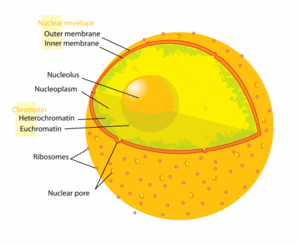The dermis is the middle layer of skin, located directly beneath the epidermis. The dermis ranges in thickness from 0.2 millimeter to 4 millimeters, depending on the location. The dermis contains a great deal of collagen and elastin which help keep maintain the durability of the dermis. The dermis also contains fibroblasts, reticular fibers, and other cells commonly seen in fibrous connective tissues. The dermis contains hair follicles, sweat glands, nerves and sebaceous (oil) glands as well. The hair follicles and nail beds are embedded within the dermis and smooth muscles are responsible for causing these hairs to respond to stimuli, such as when they contract in response to cold.
The dermis is thicker than the epidermis and is responsible for helping the body maintain its temperature, as well as providing nutrients and oxygen to some parts of the epidermis. The dermis and epidermis, although not distinguishable from an exterior view, are easily distinguishable in a histological sample due to the finger like extensions, or waves, of the dermis. These upward extensions of the dermis are referred to as the dermal papillae, while the downward extensions of the epidermis are referred to as the epidermal ridges. These upward and downward extensions help to prevent the epidermis from slipping across the dermis.
The dermis contains two layers; the papillary layer and the reticular layer.
Papillary Layer
The papillary layer is located directly beneath the epidermis. This tissue is loose and allows for the movement of leukocytes which offer protection to foreign bodies and antigens. This layer contains a great deal of blood vessels, which help supply the superior epidermis with nutrients and oxygen.
Reticular Layer
The reticular layer is deep to the papillary layer and contains irregular connective tissues. These tissues include many criss-crossing collagen fibers that form a strong network called cleavage (Langer’s) lines. When surgery is done, cuts to the skin that lie parallel with these fibers heal faster than those cut perpendicular. When the skin is stretched, due to pregnancy or rapid weight gain, these collagen fibers can become torn, producing what is known as striae, or stretch marks.
The Hypodermis
The deepest layer of the skin is known as the hypodermis. The hypodermis is often referred to as the subcutaneous layer. The hypodermis is not easily distinguishable from the dermis, but contains a great deal more adipose (fat) tissue than the dermis. The hypodermis is responsible for padding the body with fat, as well as maintaining warmth. The adipose tissue found within the hypodermis acts as a reservoir for energy and nutrients the body may need later. This adipose tissue is thicker in areas such as the breasts, hips, thighs and abdomen and is generally 8% thicker in women than it is men.
References
Saladin, Kenneth S.. Anatomy & physiology: the unity of form and function. 5th ed. Dubuque: McGraw-Hill, 2010. Print.
Skin (Integumentary) System Information
Dermis – What is the Dermis?
What is the Dermis?




